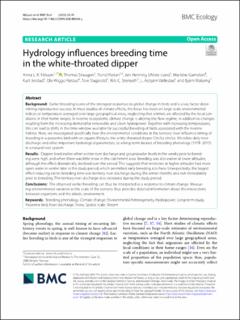| dc.contributor.author | Nilsson, Anna | |
| dc.contributor.author | Skaugen, Thomas | |
| dc.contributor.author | Reitan, Trond | |
| dc.contributor.author | LAbée-Lund, Jan Henning | |
| dc.contributor.author | Gamelon, Marlène | |
| dc.contributor.author | Jerstad, Kurt | |
| dc.contributor.author | Røstad, Ole Wiggo | |
| dc.contributor.author | Slagsvold, Tore | |
| dc.contributor.author | Stenseth, Nils Christian | |
| dc.contributor.author | Vøllestad, Leif Asbjørn | |
| dc.contributor.author | Walseng, Bjørn | |
| dc.date.accessioned | 2020-12-22T12:07:37Z | |
| dc.date.available | 2020-12-22T12:07:37Z | |
| dc.date.created | 2020-12-17T17:06:46Z | |
| dc.date.issued | 2020 | |
| dc.identifier.citation | BMC Ecology. 2020, 20, . | en_US |
| dc.identifier.issn | 1472-6785 | |
| dc.identifier.uri | https://hdl.handle.net/11250/2720780 | |
| dc.description.abstract | Background: Earlier breeding is one of the strongest responses to global change in birds and is a key factor determining reproductive success. In most studies of climate effects, the focus has been on large-scale environmental indices or temperature averaged over large geographical areas, neglecting that animals are affected by the local conditions in their home ranges. In riverine ecosystems, climate change is altering the flow regime, in addition to changes resulting from the increasing demand for renewable and clean hydropower. Together with increasing temperatures, this can lead to shifts in the time window available for successful breeding of birds associated with the riverine habitat. Here, we investigated specifically how the environmental conditions at the territory level influence timing of breeding in a passerine bird with an aquatic lifestyle, the white-throated dipper Cinclus cinclus. We relate daily river discharge and other important hydrological parameters, to a long-term dataset of breeding phenology (1978–2015) in a natural river system. Results: Dippers bred earlier when winter river discharge and groundwater levels in the weeks prior to breeding were high, and when there was little snow in the catchment area. Breeding was also earlier at lower altitudes, although the effect dramatically declined over the period. This suggests that territories at higher altitudes had more open water in winter later in the study period, which permitted early breeding also here. Unexpectedly, the largest effect inducing earlier breeding time was territory river discharge during the winter months and not immediately prior to breeding. The territory river discharge also increased during the study period. Conclusions: The observed earlier breeding can thus be interpreted as a response to climate change. Measuring environmental variation at the scale of the territory thus provides detailed information about the interactions between organisms and the abiotic environment. Breeding phenology, Climate change, Environmental heterogeneity, Hydropower, Long-term study, Passerine bird, River discharge, Snow, Spatial scale, Stream | en_US |
| dc.language.iso | nob | en_US |
| dc.publisher | BioMed Central | en_US |
| dc.rights | Navngivelse 4.0 Internasjonal | * |
| dc.rights.uri | http://creativecommons.org/licenses/by/4.0/deed.no | * |
| dc.title | Hydrology influences breeding time in the white‑throated dipper | en_US |
| dc.type | Peer reviewed | en_US |
| dc.type | Journal article | en_US |
| dc.description.version | publishedVersion | en_US |
| dc.subject.nsi | VDP::Zoologiske og botaniske fag: 480 | en_US |
| dc.subject.nsi | VDP::Zoology and botany: 480 | en_US |
| dc.source.volume | 20 | en_US |
| dc.source.journal | BMC Ecology | en_US |
| dc.source.issue | 70 | en_US |
| dc.identifier.doi | 10.1186/s12898-020-00338-y | |
| dc.identifier.cristin | 1861263 | |
| dc.relation.project | Andre: Norwegian Water Resources and Energy Directorate | en_US |
| dc.relation.project | Norges forskningsråd: 223257 | en_US |
| dc.description.localcode | Open Access This article is licensed under a Creative Commons Attribution 4.0 International License, which permits use, sharing, adaptation, distribution and reproduction in any medium or format, as long as you give appropriate credit to the original author(s) and the source, provide a link to the Creative Commons licence, and indicate if changes were made. The images or other third party material in this article are included in the article's Creative Commons licence, unless indicated otherwise in a credit line to the material. If material is not included in the article's Creative Commons licence and your intended use is not permitted by statutory regulation or exceeds the permitted use, you will need to obtain permission directly from the copyright holder. To view a copy of this licence, visit http://creativecommons.org/licenses/by/4.0/. The Creative Commons Public Domain Dedication waiver (http://creativecommons.org/publicdomain/zero/1.0/) applies to the data made available in this article, unless otherwise stated in a credit line to the data. | en_US |
| cristin.ispublished | true | |
| cristin.fulltext | original | |
| cristin.qualitycode | 1 | |

